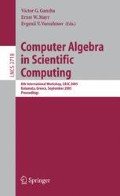Abstract
The behavior of the Cayley-Dixon resultant construction and the structure of Dixon matrices are analyzed for composed polynomial systems constructed from a multivariate system in which each variable is substituted by a univariate polynomial in a distinct variable. It is shown that a Dixon projection operator (a multiple of the resultant) of the composed system can be expressed as a power of the resultant of the outer polynomial system multiplied by powers of the leading coefficients of the univariate polynomials substituted for variables in the outer system. The derivation of the resultant formula for the composed system unifies all the known related results in the literature. A new resultant formula is derived for systems where it is known that the Cayley-Dixon construction does not contain any extraneous factors. The approach demonstrates that the resultant of a composed system can be effectively calculated by considering only the resultant of the outer system.
Access this chapter
Tax calculation will be finalised at checkout
Purchases are for personal use only
Preview
Unable to display preview. Download preview PDF.
References
Sederberg, T., Goldman, R.: Algebraic geometry for computer-aided design. IEEE Computer Graphics and Applications 6, 52–59 (1986)
Hoffman, C.: Geometric and Solid modeling. Morgan Kaufmann Publishers, Inc., San Mateo (1989)
Morgan, A.: Solving polynomial systems using continuation for Scientific and Engineering problems. Prentice-Hall, Englewood Cliffs (1987)
Chionh, E.: Base points, resultants, and the implicit representation of rational Surfaces. PhD dissertation, Univ. of Waterloo, Dept. of Computer Science (1990)
Zhang, M.: Topics in Resultants and Implicitization. PhD thesis, Rice University, Dept. of Computer Science (2000)
Bajaj, C., Garrity, T., Warren, J.: On the application of multi-equational resultants. Technical Report CSD-TR-826, Dept. of Computer Science, Purdue (1988)
Ponce, J., Kriegman, D.: Elimination Theory and Computer Vision: Recognition and Positioning of Curved 3D Objects from Range. In: Donald, K., Mundy (eds.) Symbolic and Numerical Computation for AI. Academic Press, London (1992)
Kapur, D., Saxena, T., Yang, L.: Algebraic and geometric reasoning using the Dixon resultants. In: ACM ISSAC 1994, Oxford, England, pp. 99–107 (1994)
Rubio, R.: Unirational Fields. Theorems, Algorithms and Applications. PhD thesis, University of Cantabria, Santander, Spain (2000)
Cheng, C.C., McKay, J.H., Wang, S.S.: A chain rule for multivariable resultants. Proceedings of the American Mathematical Society 123, 1037–1047 (1995)
Jouanolou, J.P.: Le formalisme du résultant. Adv. Math. 90, 117–263 (1991)
Minimair, M.: Factoring resultants of linearly combined polynomials. In: Sendra, J.R. (ed.) Proceedings of the 2003 International Symposium on Symbolic and Algebraic Computation, pp. 207–214. ACM, New York (2003); ISSAC 2003, Philadelphia, PA, USA (August 3-6 2003)
Minimair, M.: Computing resultants of partially composed polynomials. In: Ganzha, V.G., Mayr, E.W., Vorozhtsov, E.V. (eds.) Computer Algebra in Scientific Computing. Proceedings of the CASC 2004, St. Petersburg, Russia, pp. 359–366. TUM München (2004)
Hong, H., Minimair, M.: Sparse resultant of composed polynomials I. J. Symbolic Computation 33, 447–465 (2002)
Buse, L., Elkadi, M., Mourrain, B.: Generalized resultants over unirational algebraic varieties. J. Symbolic Computation 29, 515–526 (2000)
Kapur, D., Saxena, T.: Comparison of various multivariate resultants. In: ACM ISSAC 1995, Montreal, Canada (1995)
Hong, H.: Subresultants under composition. J. Symb. Comp. 23, 355–365 (1997)
Kapur, D., Saxena, T.: Extraneous factors in the Dixon resultant formulation. In: ISSAC, Maui, Hawaii, USA, pp. 141–147 (1997)
McKay, J.H., Wang, S.S.: A chain rule for the resultant of two polynomials. Arch. Math. 53, 347–351 (1989)
Zhang, M., Goldman, R.: Rectangular corner cutting and sylvester \(\mathcal{A}\)-resultants. In: Proc. of the ISSAC, St. Andrews, Scotland
Chtcherba, A.D.: A new Sylvester-type Resultant Method based on the Dixon-Bézout Formulation. PhD dissertation, University of New Mexico, Department of Computer Science (2003)
Dixon, A.: The eliminant of three quantics in two independent variables. Proc. London Mathematical Society 6, 468–478 (1908)
Cox, D., Little, J., O’Shea, D.: Using Algebraic Geometry, 1st edn. Springer, New York (1998)
Chtcherba, A.D., Kapur, D., Minimair, M.: Cayley-dixon construction of resultants of multi-univariate composed polynomials. Technical Report TR-CS-2005-15, Dept. of Computer Science, University of New Mexico (2005)
Author information
Authors and Affiliations
Editor information
Editors and Affiliations
Rights and permissions
Copyright information
© 2005 Springer-Verlag Berlin Heidelberg
About this paper
Cite this paper
Chtcherba, A.D., Kapur, D., Minimair, M. (2005). Cayley-Dixon Resultant Matrices of Multi-univariate Composed Polynomials. In: Ganzha, V.G., Mayr, E.W., Vorozhtsov, E.V. (eds) Computer Algebra in Scientific Computing. CASC 2005. Lecture Notes in Computer Science, vol 3718. Springer, Berlin, Heidelberg. https://doi.org/10.1007/11555964_11
Download citation
DOI: https://doi.org/10.1007/11555964_11
Publisher Name: Springer, Berlin, Heidelberg
Print ISBN: 978-3-540-28966-1
Online ISBN: 978-3-540-32070-8
eBook Packages: Computer ScienceComputer Science (R0)

